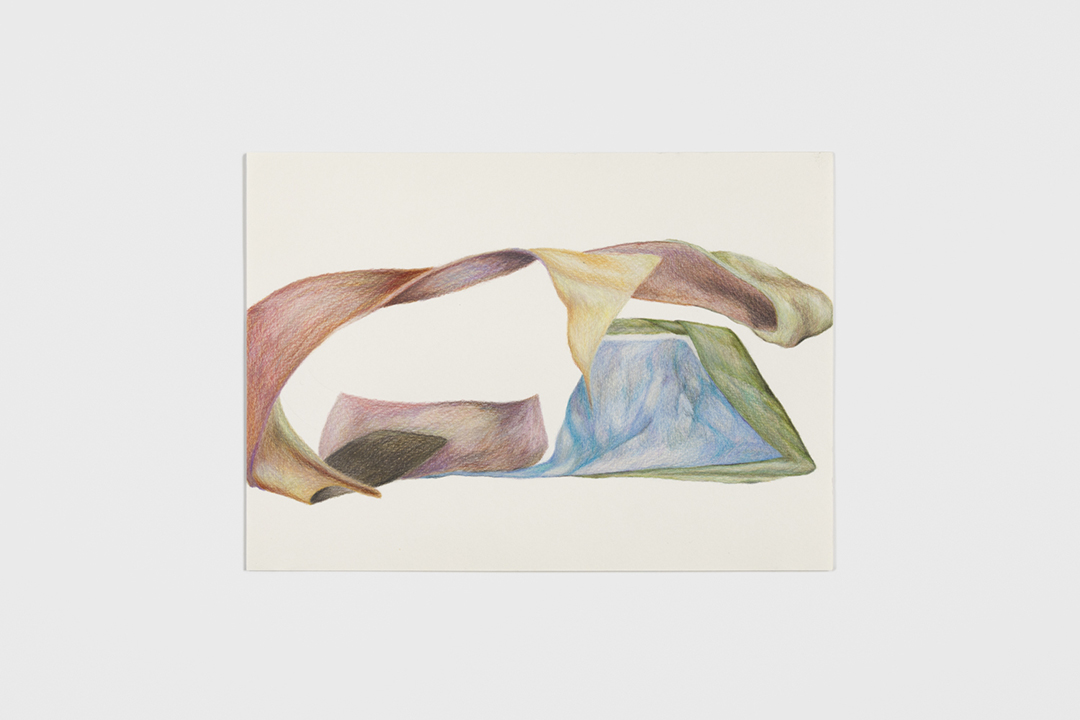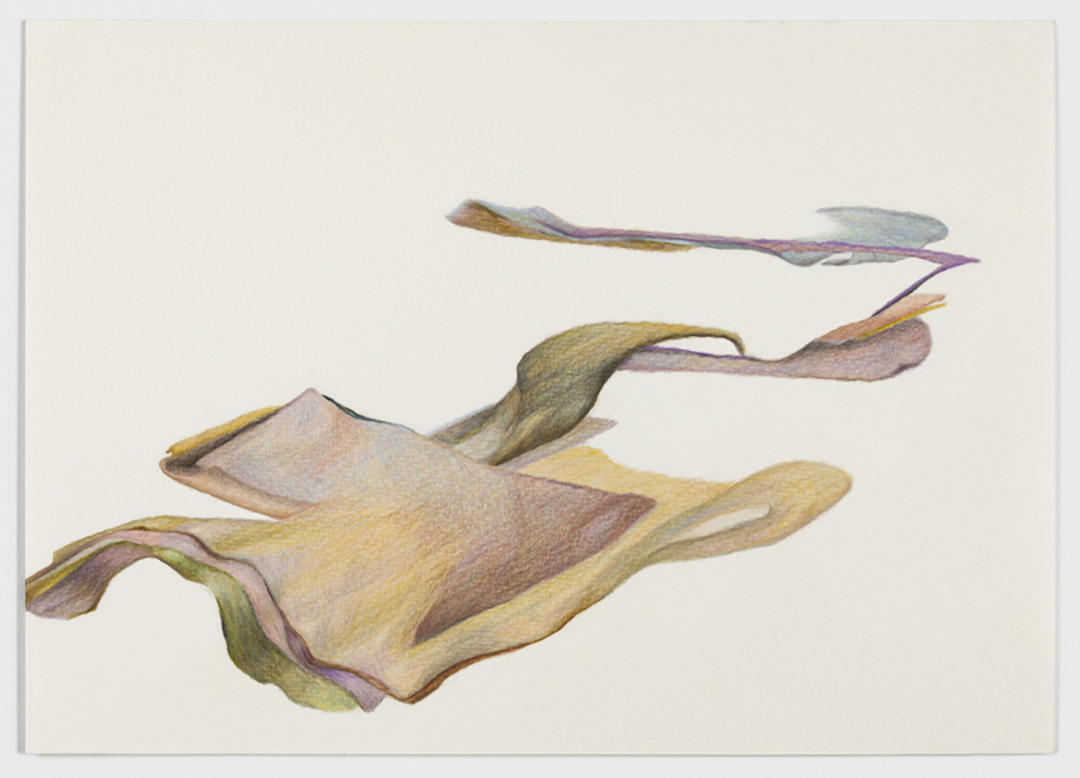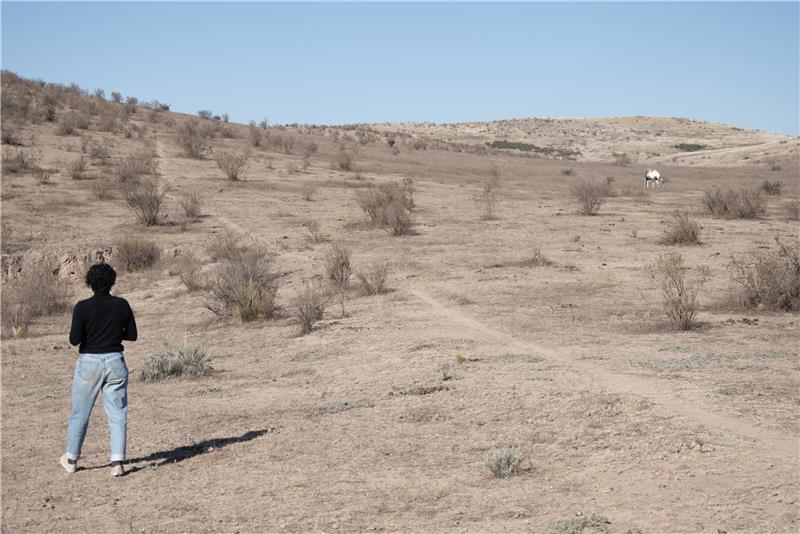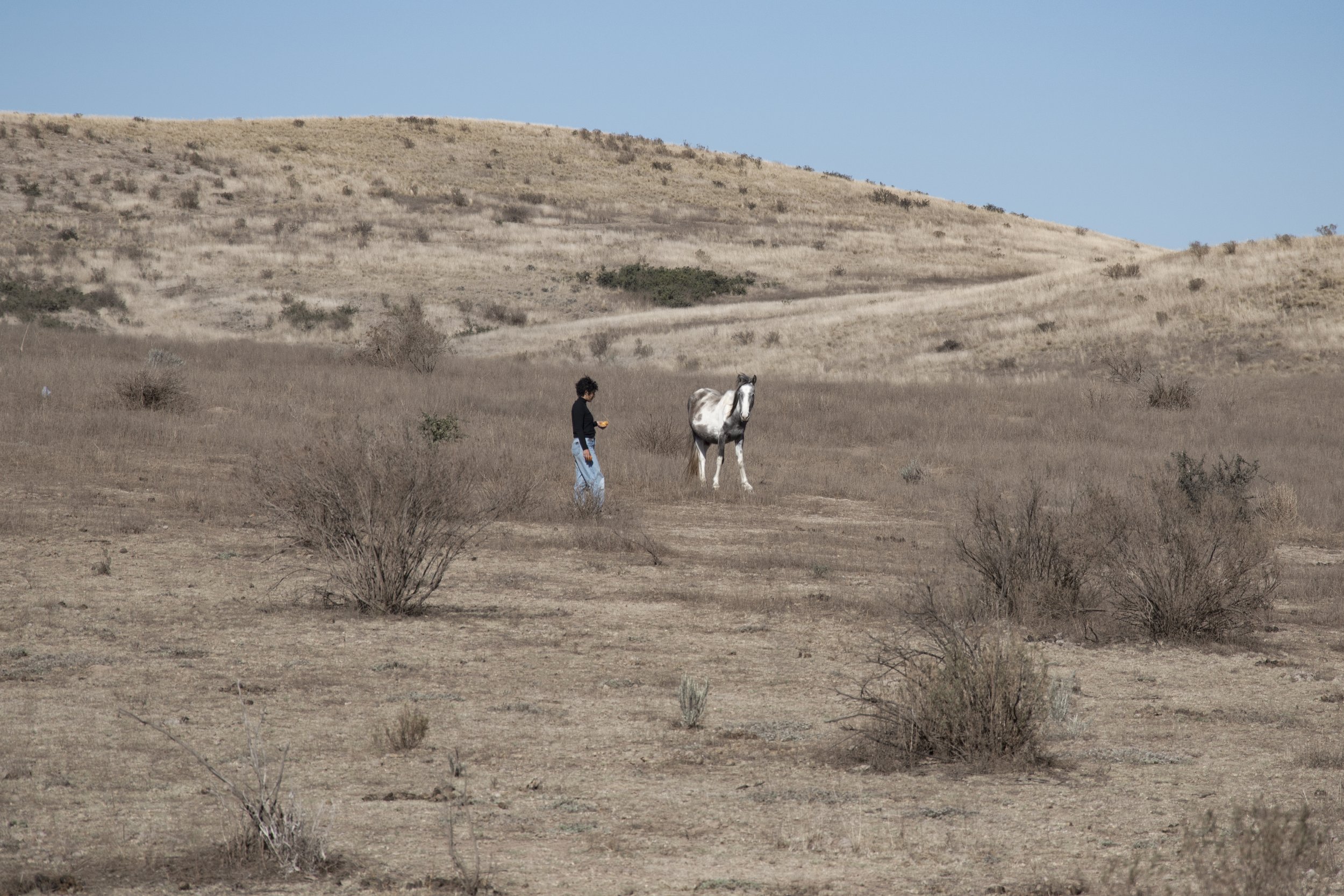Camila Vásquez –
Observaciones y reflexiones de la curadora
Septiembre 2024
Hacía un calor de locos en el taller de Florencia Sosa Rey esa tarde de mediados de septiembre en Montreal. A pesar de la tentación de ir a echarnos a un parque, ahí estábamos, concentradas y lúcidas, reflexionando juntas, haciéndonos preguntas y dejándolas sin respuestas. Entre lápices de colores, revistas, libros, papeles y dibujos pegados a las paredes, fotos y fechas límite de postulación (que nos recuerdan que los plazos se cumplen inevitablemente), retomamos una conversación que habíamos iniciado varios meses antes, cuando, conmovidas e interconectadas por un enigmático hilo invisible, hablamos por primera vez de su obra FatherDaughter (2022). Se trata de una performance en la que Florencia trabajó con su padre, iniciándolo en ese universo que a él le resultaba lejano y, al comienzo, incomprensible, transmitiéndole sus conocimientos y su experiencia. El gesto es simple y repetitivo: ambos caminan en círculos concéntricos, cruzando miradas y, al mismo tiempo, siguiendo sus respectivas trayectorias, en una cancha de fútbol, vestidos con ropa deportiva. La carga simbólica se vuelve más compleja, espesa, cuando se comprende que él era profesor de educación física en Argentina. Profesión que nunca pudo ejercer tras inmigrar a Quebec. No es de extrañar, entonces, que se me llenaran los ojos de lágrimas al ver el vídeo de esa performance, siendo yo misma parte de la diáspora latinoamericana.
Curator’s observations & reflections
September 2024
It was crazy hot in Florencia Sosa Rey’s studio that mid-September afternoon in Montreal. Despite the temptation to go lie down in a park, there we were, focused and lucid, reflecting together, asking ourselves questions and leaving them unanswered. Among colored pencils, magazines, books, papers and drawings stuck to the walls, photos and application dates (reminding us that deadlines are inevitably met), we resumed a conversation we had started several months earlier, when, moved and interconnected by an enigmatic invisible thread, we spoke for the first time about her work FatherDaughter (2022). It is a performance in which Florencia worked with her father, initiating him into that universe that was distant and, at first, incomprehensible to him, transmitting to him her knowledge and experience. The gesture is simple and repetitive: both walk in concentric circles, crossing eyes and, at the same time, following their respective trajectories, on a soccer field, dressed in sports clothes. The symbolic charge becomes more complex, thicker, when it is understood that he was a physical education teacher in Argentina. A profession he was never able to exercise after immigrating to Quebec. No wonder, then, that my eyes filled with tears when I saw the video of that performance, being myself part of the Latin American diaspora.



La cuestión que nos reunía esa tarde calurosa también tenía que ver con la transmisión de saberes y con cómo explorar la porosidad entre lo que consideramos una obra de arte formal y la práctica de facilitar talleres artísticos. Porque Florencia se mueve entre esos dos mundos y a mí me intriga cómo compartir con el público la experiencia de dar o participar en un taller, y si es posible hacerlo conservando la autenticidad del proceso creativo, tan lejos del resultado final. He sido testigo de la vulnerabilidad y el coraje con el que artistas y participantes se entregan plenamente a la experiencia de crear en el transcurso de un taller. Ese registro me interpela, por el potencial de expresión lo que lo distingue de un espectáculo o de una presentación.
Conversamos sobre algunas propuestas que exploran de manera experimental esta zona ambigua entre lo que se define como obra o como práctica: El ensayo abierto en danza contemporánea, seguido de un debate con el público; Un festival en el que no se trataba de performances en sí, sino de un periodo de práctica de ejercicios performativos con público (Festival AVEC, Sherbrooke, 2024); Un evento en el que se alternaban performances y talleres y en el que los miembros del público eran a la vez público y participantes (Studio 303, Montreal, 2024); el vídeo In Spite of the Score de Julia E Dyck (2023), que era un taller de sonido al que Florencia asistió y en el que la gente que participaba era también intérprete en el vídeo.
The question that brought us together that hot afternoon also had to do with the transmission of knowledge and how to explore the porosity between what we consider a formal artwork and the practice of facilitating artistic workshops. Because Florencia moves between those two worlds and, on my end, I am intrigued by how to share with the public the experience of giving or participating in a workshop, and whether it is possible to do so while preserving the authenticity of the creative process, so far removed from the final result. I have witnessed the vulnerability and courage with which artists and participants give themselves fully to the experience of creating in the course of a workshop. This register appeals to me, because of the potential for expression that distinguishes it from a show or a presentation.
We talked about some proposals that explore in an experimental way this ambiguous zone between what is defined as an artwork or a practice: The open rehearsal in contemporary dance, followed by a discussion with the audience; A festival in which it was not performances per se, but a period of practice of performative exercises with an audience (AVEC Festival, Sherbrooke, 2024); An event in which performances and workshops alternated and audience members were both audience and participants (Studio 303, Montreal, 2024); Julia E Dyck’s video In Spite of the Score (2023), which was a sound workshop that Florencia attended and in which the people who participated were also performers in the video.


Más allá de cuál fuera la forma que tomara la residencia ArtLab 2024-25, importaba revelar cuáles eran las motivaciones de Florencia, qué temas la habitaban y qué avenidas quería abrir. Un enfoque resultó central: Explorar sus raíces culturales sudamericanas desde la distancia y en diferido, manteniendo el carácter experimental del proyecto y alejándose del documental. Por ejemplo: ¿cómo reapropiarse del folclore a través de la abstracción? ¿Bailar sin bailar? ¿Crear ritmos sin instrumentos? O, sino (o más bien, y también), explorar por el contacto silencioso y profundo con los caballos y la equiterapia el pasado campesino de su abuelo fallecido, como un medio de acercarse a la herencia sociocultural de su país de origen, en ausencia de la transmisión oral de una tradición familiar desaparecida. Proceso que Florencia había comenzado durante una residencia de artista en la región de Catamarca, en Argentina, en el marco del proyecto Te devuelvo la mirada.
“¡Tenemos algo!”, me dice Florencia con una sonrisa en la cara. Y a mí, “algo” me dice que vamos por buen camino.
Beyond the form that the ArtLab 2024-25 residency would take, it was important to reveal what Florencia’s motivations were, what themes inhabited her and what avenues she wanted to open up. One perspective became central: to explore her South American cultural roots from a distance and in deferred time, maintaining the experimental character of the project and distancing herself from the documentary. For example: how to reappropriate folklore through abstraction? dance without dancing? create rhythms without instruments? Or, if not (or rather, and also), to explore through silent and deep contact with horses and equitherapy the peasant past of her deceased grandfather, as a means of approaching the socio-cultural heritage of her country of origin, in the absence of the oral transmission of a vanished family tradition. A process that Florencia had begun during an artist residency in the region of Catamarca, in Argentina, as part of the project Te devuelvo la mirada [I Return Your Gaze].
“We have something!”, Florencia says to me with a smile on her face. And to me, “something” tells me that we are on the right track.
